Are you practicing enough trot jumps? Many people don’t realize just how beneficial they can be. Even if you don’t do them in the show ring—for example, as you do in equitation or Handy Hunter classes—they can be a valuable part of your training program. Trot jumps are excellent for working on a young horse’s balance and timing over small jumps while his canter is still developing. At this stage, with most young horses, it’s easier to regulate the trot stride than the canter stride. By sitting quietly in the approach to the jump, you allow your horse to figure out the takeoff spot on his own. This will help him develop his own “eye” and learn how to adjust his stride without relying entirely on you to control the distances. You can then gradually progress to trotting into one jump and then cantering slowly down a line to another, which will teach your young horse to stay steady and relaxed when jumping from the canter.

For nervous or spooky horses, trotting jumps is a great way to build confidence. It gives them more time to study the fences in the approach. After they figure out how easy it is to pop over small fences from this slower speed, they quickly realize that they don’t have to race at the jumps and push hard off the ground to clear them. The slower and more relaxed they learn to be on takeoff and landing, the better their jumping efforts become.
For horses who tend to rush their approaches, making the trot jump something solid, like a wall or flower box, “holds” the horse off the jump—makes him respect it enough to actually jump it, rather than just step over it. This also allows you to put your leg on your horse and ride him forward to the fence, rather than pulling back on the reins in the approach. The latter causes the horse to either raise his head higher than the desired level, which is slightly above his withers, or curl his neck and tuck in his nose, which destroys his balance and ability to produce a quality takeoff. To get the very best jump out of a horse, I always like his nose to be pointing toward the fence and his neck to soften and even lengthen slightly in the last few strides before the jump.
Practicing trot jumps is equally valuable for riders. It gives you time to focus on staying with your horse’s stride—never getting ahead of or behind it—so that you’re in perfect balance in the air. It’s also excellent patience training: teaching you to wait quietly for the jump to come to you so that his body can rock back on takeoff rather than hunting for a distance, sometimes making a move at the wrong moment and throwing him off balance.
Besides incorporating trot jumps into my training at home, I also use them when I am buying horses. They are a great way to evaluate a horse’s natural eye and balance. Some horses don’t know where to put their legs or simply step over the small jumps. Really talented horses stay in beautiful balance right up to each fence and jump it neatly every time.
Trotting jumps is often beneficial in the warm-up ring, as well. With some horses, it’s a good tool for setting the tone for the round. I rode a horse named Calgary who always performed much better when we started his warm-up with trot jumps. He had a long canter stride that was hard to adjust, plus he was a slightly nervous horse. If I didn’t trot any fences in his warm-up, I felt like I always had to hold him back from the jumps in the show ring. He was talented enough to clear 3-foot-6 to 3-foot-9 jumps from the trot. After doing that a few times, I could ride at his canter a little more—put on my leg instead of trying to hold his canter together—without having to worry that he might get too forward. He became more rideable and confident, which resulted in much better rounds in the ring. Calgary went on to be the Junior Hunter Reserve Champion with Elise Haas at the 1994 National Horse Show.
If you are riding trot jumps in the show ring, it’s important to remember that the challenge is not just the jump. You have to stay balanced, steady and straight through the downward transition from canter, the approach to the jump, the effort in the air and the recovery afterward. I recommend starting with the following exercise.
Canter–Trot Transition to Poles
One of the most common mistakes I see with trot jumps in the show ring is the rider leaning back too far in the canter–trot transition, which causes the horse to fall into an unbalanced trot. The rider then falls behind the motion and gets stiff and rigid. This, in turn, pushes the horse out in front of her, rushing to the jump, leaning on his rider’s hands and possibly even breaking back into the canter—a fault that the judge has to penalize.
Another common problem I see in the ring is horses who tuck their noses down and in toward their chests during and after the transition, pulling their riders out of the tack. In this case, the horse often falls behind the rider’s leg (loses the desired forward momentum), and the rider gets ahead of the horse’s stride, tipping her balance up onto his neck. With his nose tucked in like this, he can’t judge the distance properly and gets closer to the jump than he should. This prevents him from rocking correctly back onto his hindquarters on takeoff and rotating his shoulders up and forward. The result is a low, unimpressive effort, with the horse jumping “over his front end.”
To avoid either of these mistakes, set up three to five trot poles about 3½ to 4 feet apart.

1. Establish a good, rhythmic canter, checking that you are balanced over your stirrups with a slightly closed hip angle before making a smooth turn toward the trot poles. About 60 feet away from the poles, prepare for the downward transition to trot by stretching your upper body tall—think “longer and stronger”—without changing your hip angle.

2. To ask for the transition, close your legs on your horse’s sides to support his balance. Then close your hands on the reins to increase the pressure. At the same time, focus on staying strong in your core (your stomach and back muscles), so that your upper body stays balanced over the horse—not leaning too far backward or forward. Most importantly, be sure that your reins are short enough that you won’t be tempted to pull your hands behind your shoulders or change your hip angle. The better your leg-to-hand connection becomes, the less likely you will be to make these mistakes.
Think of this transition as being similar to the way you’d steady a horse in a line: smooth and balanced, without any change in the level of his head carriage. The best way to guarantee this is by not changing your own balance. If he tends to drop his head below his withers, focus on using your core and legs—instead of your hands—to bring it back up. If he tries to pull you up out of the saddle, bring him all the way down to a halt. Then circle back and start the exercise from the beginning.

3. Keep your body balanced over the middle of your horse as you go over the poles in posting trot. Follow his neck forward with your hands, maintaining a light connection with his mouth.
Repeating this several times from each lead will teach both you and your horse to stay balanced and patient in the approach. As you practice this exercise over time, you’ll eventually be able to make the transition more quickly but still smoothly. The goal is to always avoid rough transitions.
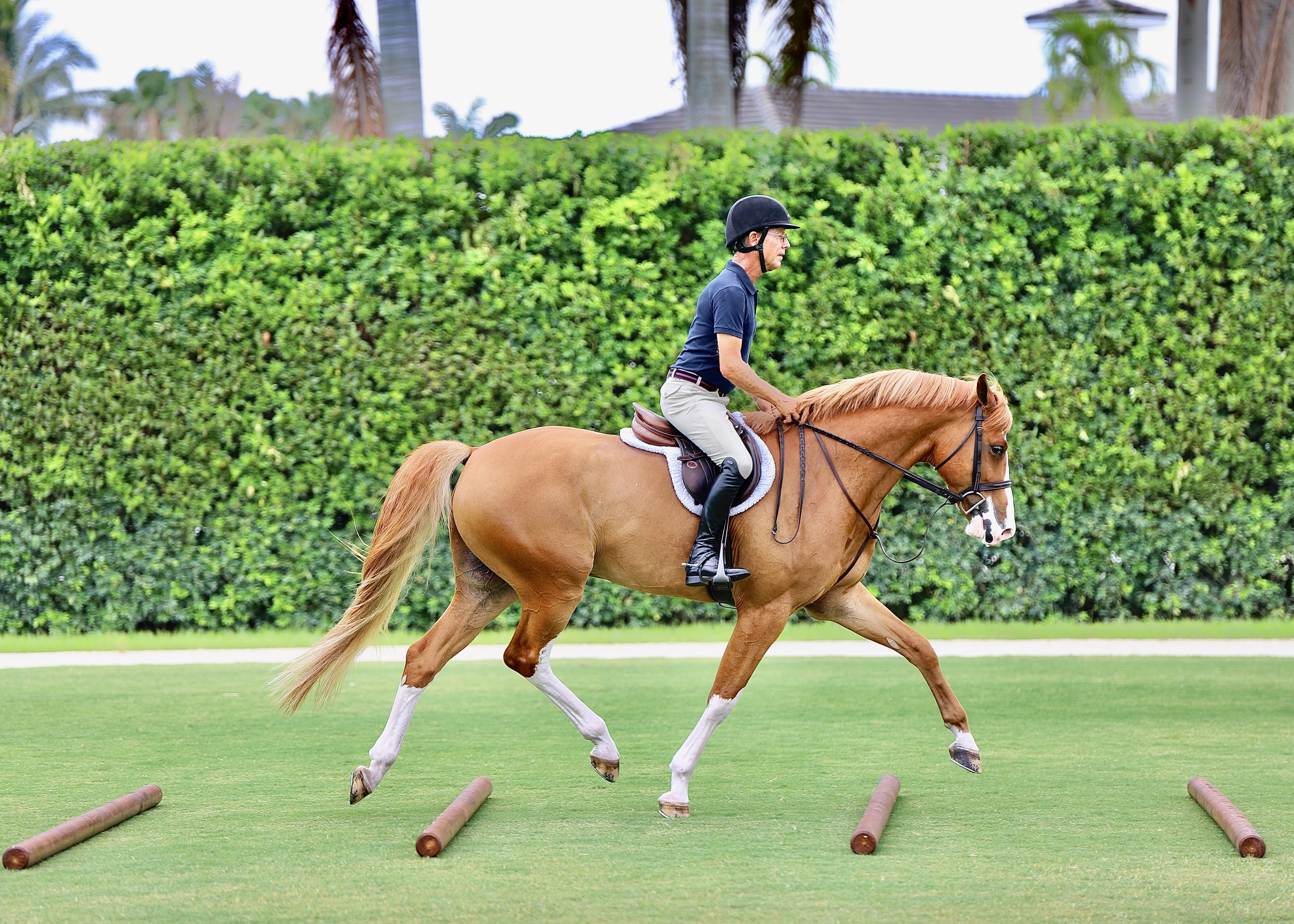
Common Mistakes
Here, I’ve allowed Babylon’s head to drop below his withers, which destroys his balance and natural, relaxed topline.

After the transition to trot, his neck is curled and shortened, preventing him from using his head and neck correctly in the approach to the poles.

Here, because I’ve used too much rein pressure in the canter-trot transition, Babylon has raised his head and shortened his neck, making it impossible to take relaxed, even steps over the poles.

Line: Canter In and Trot Out
Build an 84-foot line with a small canter fence followed by a trot jump—a small, solid jump or low vertical. (Be sure the canter jump is quite small at first, so your horse doesn’t feel like he has to make a big effort over it. For the trot jump, avoid using gates or other jumps with holes in which he might accidently get a foot stuck.) Place a trot pole 8 to 9 feet in front of the trot jump. If your horse tends to get quick on the landing sides of his fences, build this line so the trot jump is just a few strides away from the end of the arena. That way, he’ll be thinking about the turn as he lands, rather than racing off into a big, open space.
Note: If your horse is green and hasn’t begun cantering fences yet, set up only the second element of this line, with the trot pole, and practice making a canter-trot transition before it just as you did with the trot-pole exercise.

1. Establish a slightly collected canter and ride a smooth turn to the first jump. Keep your upper body quiet in the approach, avoiding pushing for a long spot, so your horse doesn’t overdo his effort over it. (Because the jump is so small, it’s OK if you get a little closer than usual to it on the takeoff.) In the air, focus your eye on the trot jump while being careful not to interfere with your horse’s jumping effort.
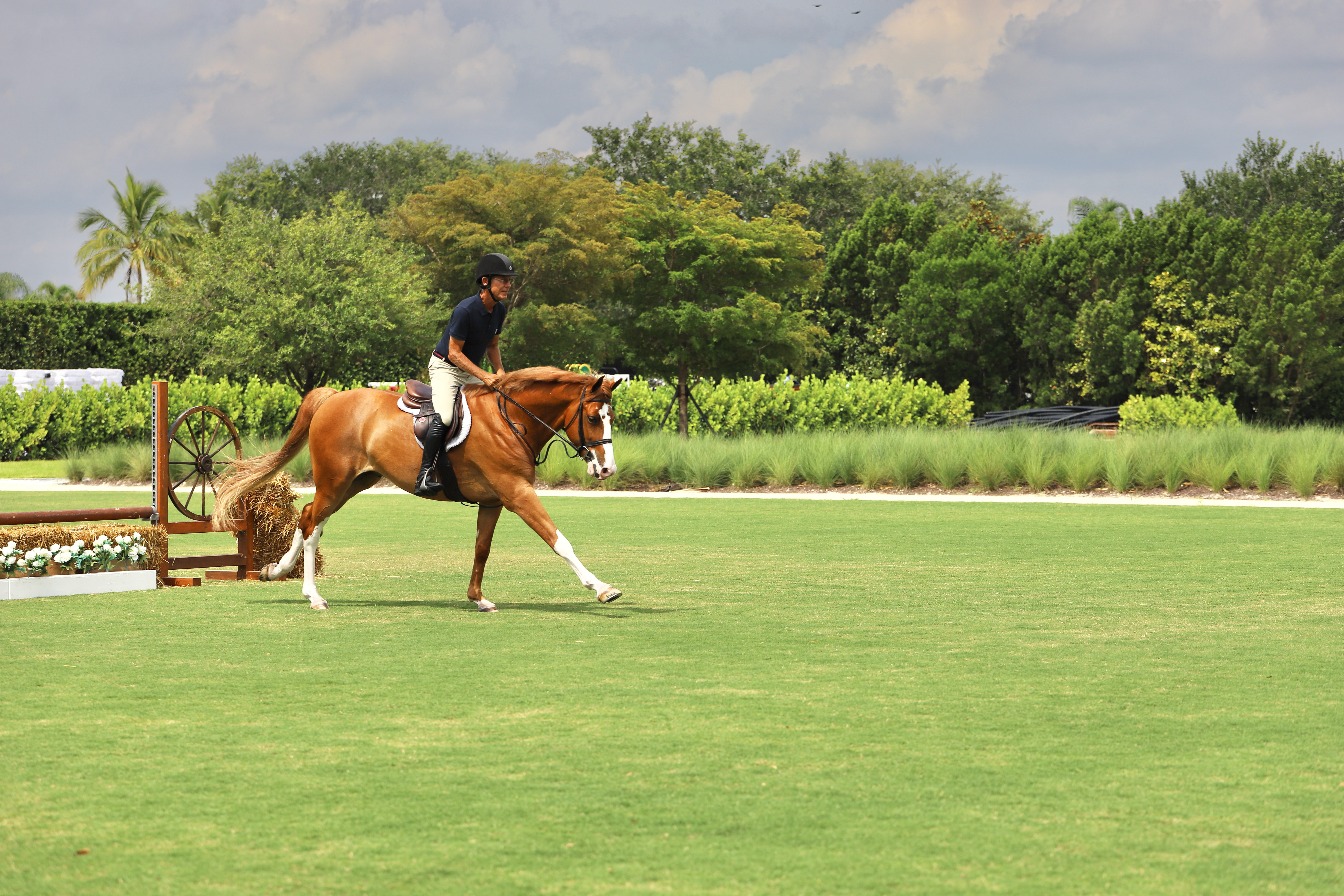
2. After he has fully completed the jump, apply the same smooth downward aids that you applied for the canter–trot transition (being careful to use your core and legs more than your hands), this time asking your horse to come all the way down to a halt. Pause in the halt briefly—just long enough for him to relax his neck—then turn and walk calmly away. (If he drifted in either direction before the halt, turn him in the opposite direction. So, for example, if he drifted left, turn him right.) If you have trouble making the transition to halt in the space of this line, make the line a little longer, approach the first jump in an even more collected canter, and/or make a tighter turn in the approach.
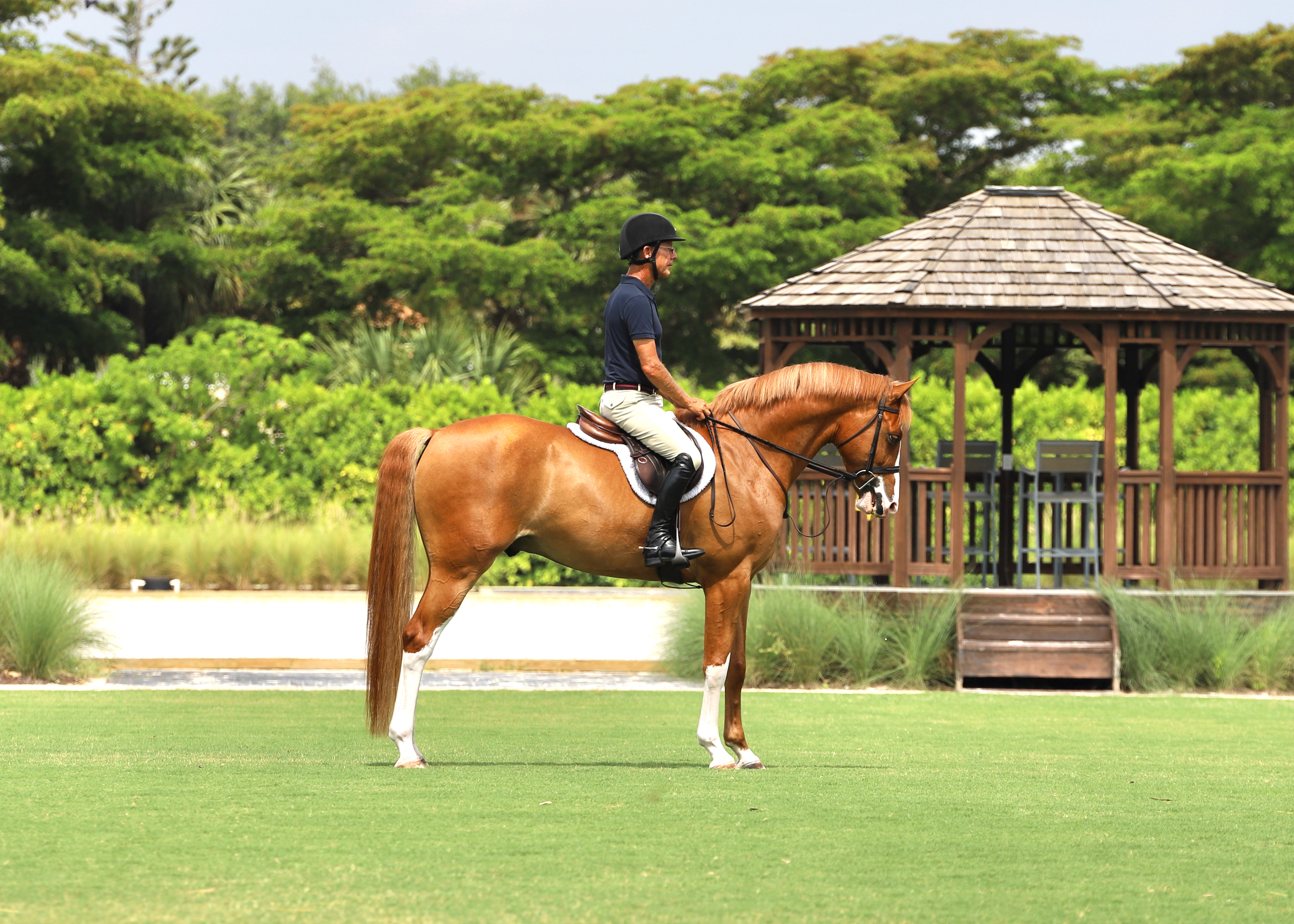
3. Repeat the exercise until you can make the halt transition easily halfway down the line without changing the level of your horse’s head carriage. Then approach the canter jump again just as you did before. This time, instead of coming down to a halt, ask for a transition to trot. Just as you did in the trot-poles exercise, immediately check that your balance is right in the middle of your horse’s stride and that he feels in front of your leg—carrying the forward momentum you want without you having to nag him—and “at your hand”—taking a light feel of the bit without pulling you out of the saddle. This timing can be tricky to master. As he’s making the downward transition, he may feel like he’s going to come all the way down to the walk. Be ready to apply leg and seat just before that moment, so that he trots forward in a steady—neither sluggish nor rushed—rhythm. Again, if your horse curls his neck or raises his head higher than the ideal level just above his withers, check that you’re staying tall in your upper body and not using too much rein pressure in the transition.

4. Continue to focus on your balance in the approach to the trot jump, while counting the strides out loud—one, two, one, two—to maintain a steady rhythm and resist the temptation to rush to the takeoff. Don’t look for a distance; instead, try to feel what your horse is doing underneath you and let him decide when to take off. Meanwhile, follow his nose forward with your hands, allowing him to use his neck properly in the last few strides before the jump.
Keep your eyes up as you get close to the jump, focusing on the track you plan to ride beyond it. This, in turn, will help to keep your horse’s eyes up. Unless he is a superb trot jumper who never loses his balance on takeoff, avoid the temptation to throw away the reins in front of the jump. Keeping a light feel of the contact will help you maintain his balance all the way to the takeoff and ensure that you go with him when he leaves the ground. Meanwhile, keep your hip angle slightly closed, with your hands in front of your shoulders.
Whether you sit or post in the last few strides before the trot jump depends on your horse’s trot. If he has a flatter, less energetic trot, continue posting to encourage an active rhythm in his step and to clarify that you’re not intending to come all the way to the walk. For the very last stride or two (just after he steps over the trot pole), it’s OK to sit lightly in the front of the saddle, still maintaining the same hip angle, to help yourself stay with his motion on takeoff. If he has a lot of energy and suspension in his trot, sit several strides before the trot pole to relax his stride and discourage him from breaking into the canter.
Try not to anticipate the takeoff. Instead, wait for your horse’s body to come up to you. As he leaves the ground, stretch up tall with your upper body, still keeping the angle in your hips, and tighten your core muscles to stay with the motion. If you’re a hunter rider who tends to be a little more casual and soft with your upper body over canter jumps, this is the one time when you want to “equitate” more. Be patient and strong in your upper body, so you don’t accidentally jump ahead of the motion or get left behind.
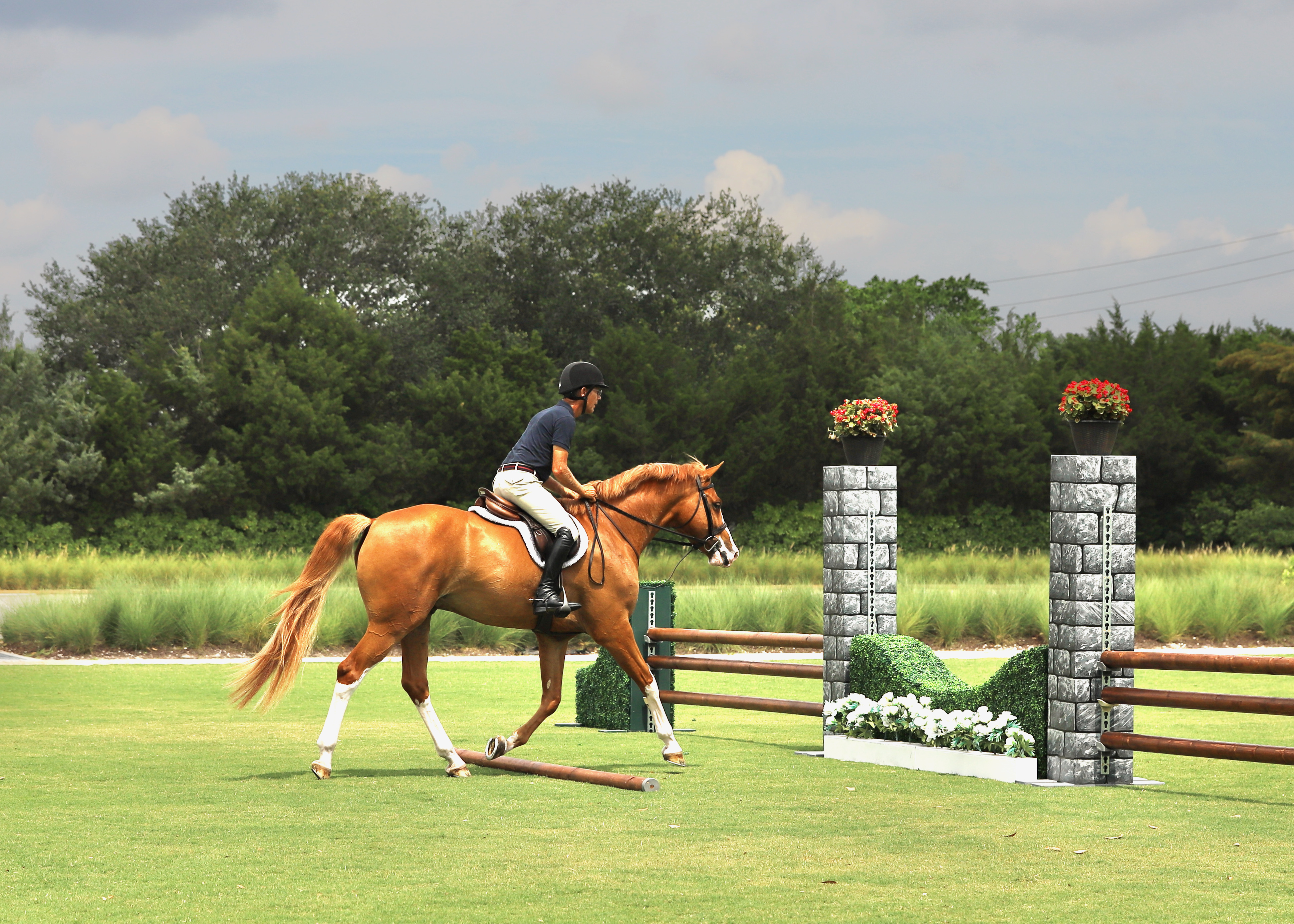
As your horse lands and canters away, stay connected to his mouth and in control of the rhythm, straightness and balance. The more quickly you organize after the jump, the better your turn or line will be to the next fence. If he gets too quick or too low with his head and neck, use the same smooth downward-transition aids that you used earlier to gradually bring him to a walk, without pulling his nose in toward his chest. Then repeat the exercise and the walk transition until he relaxes and learns to steady himself after the jump without ever changing his head and neck position.
Canter straight after the trot jump several times before practicing right and left turns following the landing, always focusing on keeping the even rhythm and balance and the same position of your horse’s head and neck. Also, gradually experiment with longer approaches to the canter jump, testing that your horse can maintain his balance and rhythm across a greater open space.
Because trotting small jumps is so easy on horses’ legs, you can do this as often as three or four times per week. If your horse is on the nervous side, occasionally incorporate trot jumps into his flatwork. This will teach him that jumping is not such a big deal.
Common Mistakes
I’ve allowed my reins to get too long here, bringing my hands behind my shoulders. This will make it harder to create a balanced transition to trot.

Here, I am leaning too far back during the transition and pulling on the reins, with my hands too high. This will cause me to fall behind the motion at the takeoff for the jump.
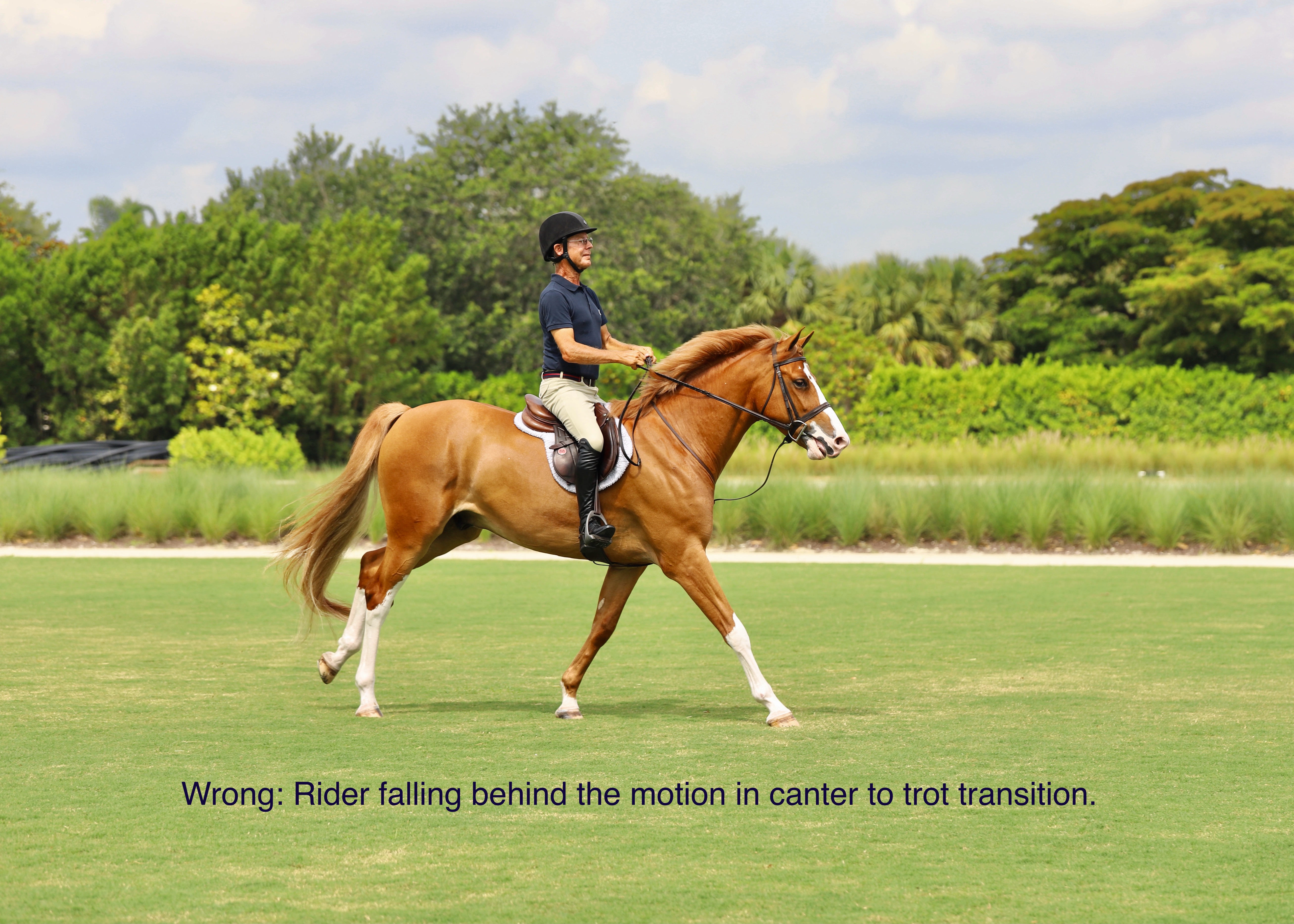
For horses who tend to get quick in the landing, I set the trot jump closer to the end of the ring, with a landing pole 8 to 9 feet away from the jump. This helps to slow them down.

In the Show Ring
Once you’ve practiced plenty of trot jumps at home, you’ll have an idea of what will work best for your horse in the show ring. For example, if he tends to anticipate and canter in the last strides before the jump, plan to make a tighter turn in the approach to it. That way he won’t have as much time to think about it. If he’s on the more timid, spooky side, consider giving him a longer approach, so he has time to focus on the jump and gather his confidence.
If your horse tends to get quick on the landing side, plan to make an earlier turn after the trot jump. This will give him less time to build up steam.
If you’ve done your homework, your horse will wow the judge with his very best effort.
About John French

Champion hunter/jumper rider John French broke onto the A-circuit as a Junior by catch-riding other people’s horses and ponies. He won the Maryland Equitation Finals self-trained and on a borrowed horse. Since then, he has represented the United States in Nations Cups and FEI World Cup™ Finals, won the title of World Champion Hunter Rider four times, the California Professional Horsemen’s Association Pre-Green Incentive Rider of the Year three times and the West Region U.S. Hunter Jumper Association Hunter Derby Rider of the Year annually since 2016. He was the 2019 WCHR Professional National Champion and was inducted into the National Show Hunter Hall of Fame the following year. John is now based in Wellington, Florida, where he oversees the hunter division of show jumper Kent Farrington’s business, KPF.
This article originally appeared in the Fall 2021 issue of Practical Horseman.











